Noodles from Noodles from Noodles: A Q&A with Kyo Maclear and Gracey Zhang About Noodles on a Bicycle Interview
First and foremost, I would like you to look at this colorized photograph from 1935:

No, it is not a fake. It has not be altered or amended or changed in any way apart from the colorization. That man is delivering soba noodles around town on a bike. He is not an outlier either. For a long time, it was common to see guys like this biking around Japan with perfectly balanced noodles just like this. And so, naturally, on August 27th of this year, you will get to see this upcoming book by Kyo Maclear, illustrated by Gracey Zhang:
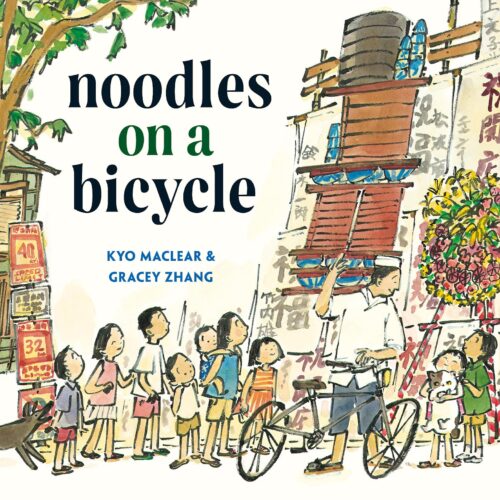
Maclear and Zhang may sound like a familiar pairing since back in 2021 they worked together on The Big Bath House, a book I called “incredibly sweet and loving and natural” at the time. It turns out that when you pair these two creators together, they happen to make just the best books. Noodles on a Bicycle is the proof in the pudding, as they say.
ADVERTISEMENT
ADVERTISEMENT
You’re curious? Heck yeah, you’re curious. So let’s talk to the creators and find out more:
Betsy Bird: Kyo, thanks so much for talking with me about NOODLES ON A BICYCLE. The book feels very much like a spiritual successor to THE BIG BATH HOUSE, and not simply because you and Gracey paired on that book as well. Like that title, this one feels like a deep dive into someone’s memory, yet it’s also pertinent and real to kids today. Where did NOODLES come from?
Kyo Maclear: Thank you so much, Betsy. It’s always a pleasure to chat with you. I’m so tempted to write “NOODLES” and allow that to be my entire response here. i.e., NOODLES came from noodles, the best and most blissful food I can imagine.
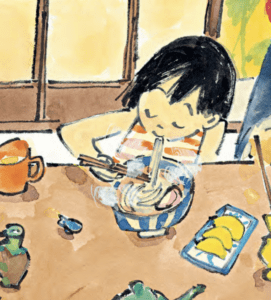
But the longer answer is this story came from childhood memories. Sensory memories of the demae arriving with heaping trays of food, round soba bowls with curls of steam, my entire family huddled around a low table, the heat rising against my face and the rhythms of people talking and slurping noodles. It came from memories of how the city of Tokyo sounded and the feeling of all that could happen in day. Gracey somehow managed to translate this entire memory archive and sensorium onto the page because she is MAGIC. Every spread is alive, which makes me happy because with both this book and The Big Bath House, I knew I didn’t want to write from outside the experience—through the filter of nostalgia. I didn’t want this story to be a paean to a time. I don’t think children are enticed by something an adult remembers. I wanted readers to feel fully immersed in the scene and childhood world.
I’m a believer that the small, specific experience can lead somewhere large. I think of Scorsese who set a dozen of his films in his hometown of New York City, somehow telling stories that transcend time and location.
I’m obviously not Scorsese but I did want this book to feel timeless and contemporary. Soba is basically fast, warm, comfort food and I think many families and cultures have a version of this, something shared and familial.
BB: Who says you’re not Scorsese? I’ll take issue with you there, but speaking of Gracey Zhang, Gracey! Thank you so much for answering my questions today! I’m burning with curiosity, so I have to ask: Were you already familiar with these bicycling deliverymen before Kyo wrote this manuscript, or did you learn about them when you first read it?
Gracey Zhang: No I wasn’t! I looked them up after reading the manuscript and did a deep dive. I fell in love with the visual world immediately of towering trays and whizzing bikes.
BB: Well, then just to follow up on that, tell us a little bit about the research you did to get the look of the book just right. Kyo mentions in her Author’s Note that the deliverymen only really existed between the 1930s and 1970s. Your art tips your hat to that time but feels timeless in the process. What did you use for a visual reference?
GZ: I had an insane amount of reference photos for this book. Many for the bikes, even more for the streets and signs, and looks for just the right models of cars. Every city has their own unique visual pattern so scouring as many references as I could so I had a visual baseline for what felt “right” was important to me. I ended up getting very picky about the kinds of cars and buses I wanted to draw on the streets and ended up mixing models of the 1950s to the late 1960s. Most of my references came from screenshots of some very helpful Youtube clips, and googling lots of old online photo collections. I found myself repeatedly revisiting this Youtube clip, it has so much good stuff that I tried to use in the book.

I deleted a lot of the images I had saved because they were taking up too much space on the laptop but this is an example of some the images I was using. Also while researching, happened upon the photos of Marc Riboud which were so lovely and really influenced a lot of how I chose to portray the people in the street scenes, also directly referenced some of the dresses from his photographs.

BB: Kyo, Was there always an intention to follow up THE BIG BATH HOUSE with another story set in Japan with Gracey doing the art, or was this a surprise to you? And might we see more?
KM: There was no conscious intention. I just went with where my heart and stomach took me. For the past few years, I have also been trying to write stories that light up my mother, who has dementia. My mother is obsessed with noodles, seems to fall asleep dreaming of them, leaves me thirty phone messages a night asking for “more noodles.” Noodles for my mother are the food of her childhood. They are love and joy and she eats them until she is stuffed full of memories.
I knew Gracey would inhabit this story fully, with all her senses. I was thrilled when she signed on. I would love to work with her again. Her art fills me up the way noodles fill up my mother. (I have a little idea that is waiting for the right moment to be written.)
BB: That sense of inhabiting the story fully, as you say, is so clear in the setting as well. Gracey, did you set the book somewhere specific, or are you keeping it vague on the page?
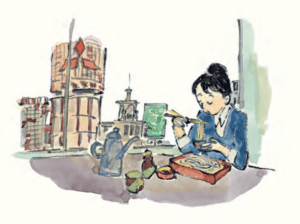
GZ: I put some small hints here and there in the book. I set the home of the children in a quieter street outside the heart of the city but in one of the spreads you can see the San’ai building tower (with the Mitsubishi logo) outside the window of the office worker which is in Ginza, Tokyo. “The original tenants were Nissan and Toyo Rayon on floors 1 ~ 3, and a Mitsubishi showroom on floors 4 ~ 9. Mitsubishi used the advertising billboard above from 1963 to 1990. “ But apparently this building is to be demolished in the next few years, cities and their ever changing landscapes.
BB: That does make me wonder about changes between the past and the present. Kyo, how much of the book is autobiographical? Did you and other kids really try to balance bowls like the demae or did you just watch them from the sidelines?
KM: There are definitely autobiographical elements but it’s mostly fiction. For starters, I am an only child and my dad wasn’t Japanese or a demae. But I remember the crowded Sobaya (soba restaurant) near my aunt’s house and the acrobatic cyclists weaving through traffic with their towering trays of food. I didn’t balance bowls like the demae but I did play ‘Noodle Shop’ and serve ‘steaming bowls’ of string and twine to my confused aunties.
BB: Speaking of aunties, Gracey, as in your previous work with Kyo, THE BIG BATH HOUSE, the heart of this book is that it’s a family book (though you don’t really know that until the end). What was your favorite part of the story to illustrate?
GZ: I feel so fortunate that with every project I work on with Kyo, I’m able to place some of my own family’s story in there as well! Growing up I was often taken back to Taiwan in the summer and being cared for by my mother’s sisters where she was the oldest of 5 girls and 1 boy which paralleled THE BIG BATH HOUSE so much. All those aunties and their big bags. For NOODLES ON A BICYCLE, the manuscript mentions 6 kids which seemed too good to not put my mother and her 5 sisters and infant baby brother in. She has a set of twins as younger sisters so I put them in with their matching bowl haircuts (one is wearing the checkered/gingham shirt and the other in the striped dress.) I had a lot of fun with clothing research as well as the signage and street shops.
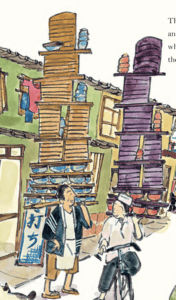
BB: God, I love that. Now Kyo, in your Author’s Note you mention that this method of delivery was being phased out when you were a child, to be replaced by motorbikes. You then say, “Of course, there are practices worth improving, but there are also things worth remembering and celebrating.” Could you say a little bit more about the necessity of remembering something as extraordinary as these workers?
KM: I mean, the demae were extraordinary with almost circus-level skill. But I think there is something generally extraordinary about the work of food delivery—whether it be the first pizza delivery guys in 1880s Italy or the Dabbawallas delivering hot lunch in tiffin to workers in India or the North American delivery app riders of today. There is honor in the hard work of providing sustenance for your family and others while performing often perilous feats of strength and speed. Sadly, this kind of physical work tends to be devalued both economically and symbolically. My younger son pointed out to me recently that he has rarely seen stories about working people in literature. He wonders where he can find books about plumbers, electricians and roofers. I know they exist but maybe not so plentifully. I think that’s why I loved Richard Scarry books as a child. They felt rare in part because they showed labor.
BB: Labor went into the art of this book as well. Gracey, was there any aspect of this book that you found challenging to depict?
GZ: Having to practice my calligraphy skills again. I had sent some WIP photos to my mother and she flagged my atrociously sloppy calligraphy immediately (it’s been a while I’ll admit). Coincidentally she was visiting me in New York not too long after that so we ended up having some late night writing practice together.
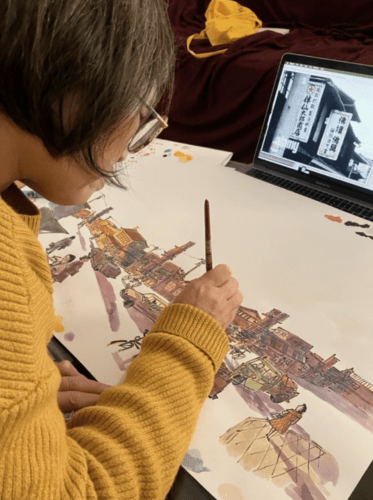
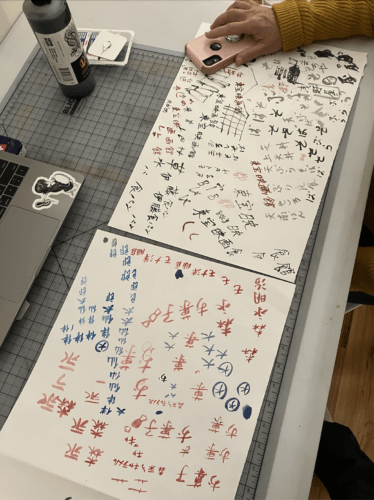

BB: Kyo, I think the decision to include a photograph of a deliveryman with noodles stacked impossibly high right at the beginning of the book on the endpapers was the right one to make. Was that your idea from the start or an editorial decision?
ADVERTISEMENT
ADVERTISEMENT
KM: In researching this book, I came across wonderful photos of demae from across the decades. I loved the way the delivery men’s expressions ranged from nonchalant to hypervigilant depending on the load they were carrying and the traffic they were navigating. I included a few of these photos with my story submission but it was my editor Annie Kelley’s brilliant idea to bookend the story with them.
BB: Well, this has been brilliant. My final question then to the two of you is what do you have coming out after this? What’s next on your plate?
KM: I have a special ghost story coming out with Enchanted Lion later this year, titled There’s a Ghost in the Garden. It was conjured almost by séance with Claudia Zoe Bedrick and my friend-collaborator, Katty Maurey. I can’t wait for readers to step into the world Katty created. She brought such deep mystery and tender atmosphere to this story about the ghosts, traces, and memories that populate our lives. Another book I’m ridiculously excited about is The Inactivity Book, which playfully explores ‘inactivity’ as a cauldron for creativity. It’s forthcoming with Annie Kelley/Random House Studio and will be illustrated by Tracy Subisak, maestro of lyric humor, who has a beautiful ability to capture children in all their rollicking and (occasionally) rest-seeking glory.
GZ: I had my second author/illustrator book come out last summer, WHEN RUBIN PLAYS. I just heard the draft mix for the audio edition and it made me laugh out loud, hopefully when it’s available on Audible, children and adults do too. I illustrated author Carlos Matias’ debut, EMERGENCY QUARTERS a story set in 90s Queens, New York which will be out in Spring, and currently working on illustrating a book with Chronicle that I hope to share some news on soon!
Thank you for these lovely questions Betsy, it’s always so fun to share the process behind these books and this one lives close in my heart <3
The pleasure, I must say, was entirely mine. Honestly, you readers are going to get such a kick out of this book when you finally get to see it. I want to heap great loads of thanks onto Ann Kelley and the folks at Random House Studio for helping to put this together. Additionally, I physically cannot thank Kyo and Gracey enough for this peek into what is bound to be a universally beloved book. Noodles on a Bicycle comes out August 27th so be sure to look for it on bookstore and library shelves everywhere then.
Filed under: Best Books, Best Books of 2024, Interviews
About Betsy Bird
Betsy Bird is currently the Collection Development Manager of the Evanston Public Library system and a former Materials Specialist for New York Public Library. She has served on Newbery, written for Horn Book, and has done other lovely little things that she'd love to tell you about but that she's sure you'd find more interesting to hear of in person. Her opinions are her own and do not reflect those of EPL, SLJ, or any of the other acronyms you might be able to name. Follow her on Twitter: @fuseeight.
ADVERTISEMENT
ADVERTISEMENT
SLJ Blog Network
Name That LEGO Book Cover! (#53)
Exclusive: Vol. 2 of The Weirn Books Is Coming in October | News
Fighting Public School Book Bans with the Civil Rights Act
Take Five: Middle Grade Anthologies and Short Story Collections
ADVERTISEMENT








I love everything about this.
I love everything Kyo Maclear creates.
I love everything Gracey Zhang creates.
I also have a little hobby of “collecting” (in my. mind) books set in NYC but especially the outer boroughs and am thrilled to see another book set in Queens is coming out. (I have written my own picture book set in Queens but it has yet to be published…) Staten Island is the hardest to find.
Looking forward to reading this.